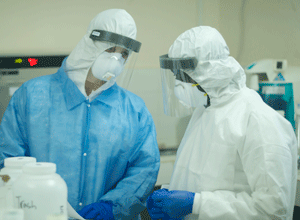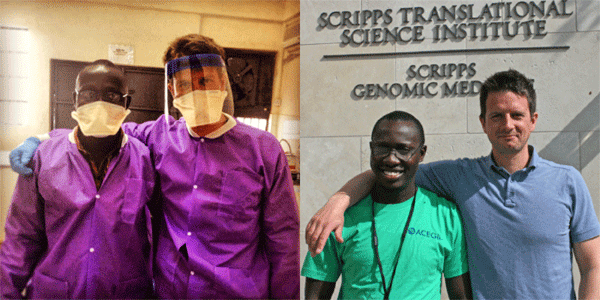Scripps Translational Science Institute’s latest faculty recruit publishes key findings
In 2009, a large international consortium of researchers, clinicians and laboratory scientists launched a study into one of the world’s deadliest and most underresearched pathogens. The virus, called Lassa, is endemic in West Africa and can cause infected patients to develop a hemorrhagic fever, similar to individuals suffering from Ebola virus disease. Like Ebola, Lassa fever has an extremely high case fatality rate with thousands of people dying each year, and tens of thousands being hospitalized. Working with live samples requires Biosafety level 4 containment and the virus itself is ranked as a Category A Bioterrorism Agent by the US Centers for Disease Control and Prevention. Yet few outside West Africa have heard of it.
This same group of researchers, including Scripps Translational Science Institute’s (STSI) newest faculty recruit, Dr. Kristian Andersen, has now published groundbreaking findings about the origins and evolution of the virus. The study, published on the front page of Cell in August 2015, used next generation sequencing to analyze the genome of almost 200 Lassa virus samples from clinical and rodent reservoir samples obtained in Nigeria and Sierra Leone. This dataset now forms the largest catalog of Lassa virus sequences generated to date.

The study was made possible through collaborations with two hospital sites in West Africa – Irrua Specialist Teaching Hospital in Nigeria, and Kenema Government Hospital in Sierra Leone – as well as a number of partners in the United States and Europe, including Harvard University, Broad Institute, Tulane University and The Scripps Research Institute (TSRI). Together they form the Viral Hemorrhagic Fever Consortium.
The data collected for this study led to several important discoveries. While Lassa was first identified in 1969, the genomic data uncovered that the virus has origins dating back more than 1,000 years to modern-day Nigeria. It appears that the virus then spread to other West African countries, including Ivory Coast, Liberia and Guinea, emerging in Sierra Leone an estimated 150 years ago.
The study also demonstrates that Lassa virus infection in humans is typically the result of a “spillover” event from the rodent reservoir, Mastomys natalensis. While human-to-human transmission of Lassa does occur, particularly in hospital settings, these instances were found to be rare. This is in contrast to Ebola outbreaks, which are typically sustained by human-to-human transmission. “What this tells us, is that our approach to containing outbreaks of Lassa needs to be different from our approach to containing Ebola,” says Dr. Andersen, who is also Assistant Professor of Immunology and Microbial Science at TSRI, and Director of Infectious Disease Genomics at STSI. The findings support evidence that while stopping the spread of Ebola can be achieved by breaking the human-to-human transmission chain, Lassa requires the prevention of “spillover” events, using tools like vaccination and pest control.
As remarkable as the discoveries unearthed as a result of this study are, also noteworthy is the impressive scale of the international collaboration that forms the foundation for this work. More than 70 researchers from 19 different institutions spanning academic, non-profit, governmental, medical, and commercial sectors contributed to the study. Local partnerships in West Africa are key to conducting this type of research. “It’s different from studying say HIV, where you can obtain samples from patients here in the US. Lassa is only present in West Africa, so that’s where we have to work and invest in infrastructure and capacity building. This research also requires highly skilled people, and that’s why training was a huge part of this study,” says Dr. Andersen. Ensuring staff is equipped to obtain samples from patients safely, diagnose patients rapidly and accurately, and store samples successfully, is vital to enabling this research. Workshops are organized annually in the US, and researchers ensure that they incorporate training into their site visits to West Africa.

There are also many technical and logistical challenges to conducting research on a pathogen that can only be found on the other side of the globe. “From a technical perspective there are things like maintaining a cold chain that present significant challenges,” Dr. Andersen explains. Obtaining a sample from a patient in the field, deactivating it, freezing it down, and transporting it 5,000 miles away is no small feat. Unreliable electricity, lack of dry ice, and customs regulations all present added hurdles beyond the sequencing and analysis of subsequent data. From a communications standpoint, coordinating communication across multiple time zones and spotty cell phone reception also add to the difficulties.
But overcoming these different challenges only adds to the rewards of conducting the research in the first place. When discussing what he enjoys most about his research, Dr. Andersen lists the opportunity to work with people who are directly impacted by the disease, and the potential to influence efforts to ultimately eradicate Lassa from West Africa. For example, by generating this sequence catalog, other partners involved in the study have already been able to start updating diagnostics so that they are more precise. “So based on this work, we’ll be able to create better diagnostics that will enable quick and accurate diagnosis of patients with a potential hemorrhagic fever,” says Dr. Andersen. “Understanding what the virus looks like and how it changes over time is also critical for successful vaccine design.”
Related links –
Learn more about the Viral Hemorrhagic Fever Consortium
Visit the Andersen Lab website
The Scripps Research Institute – News & Views
